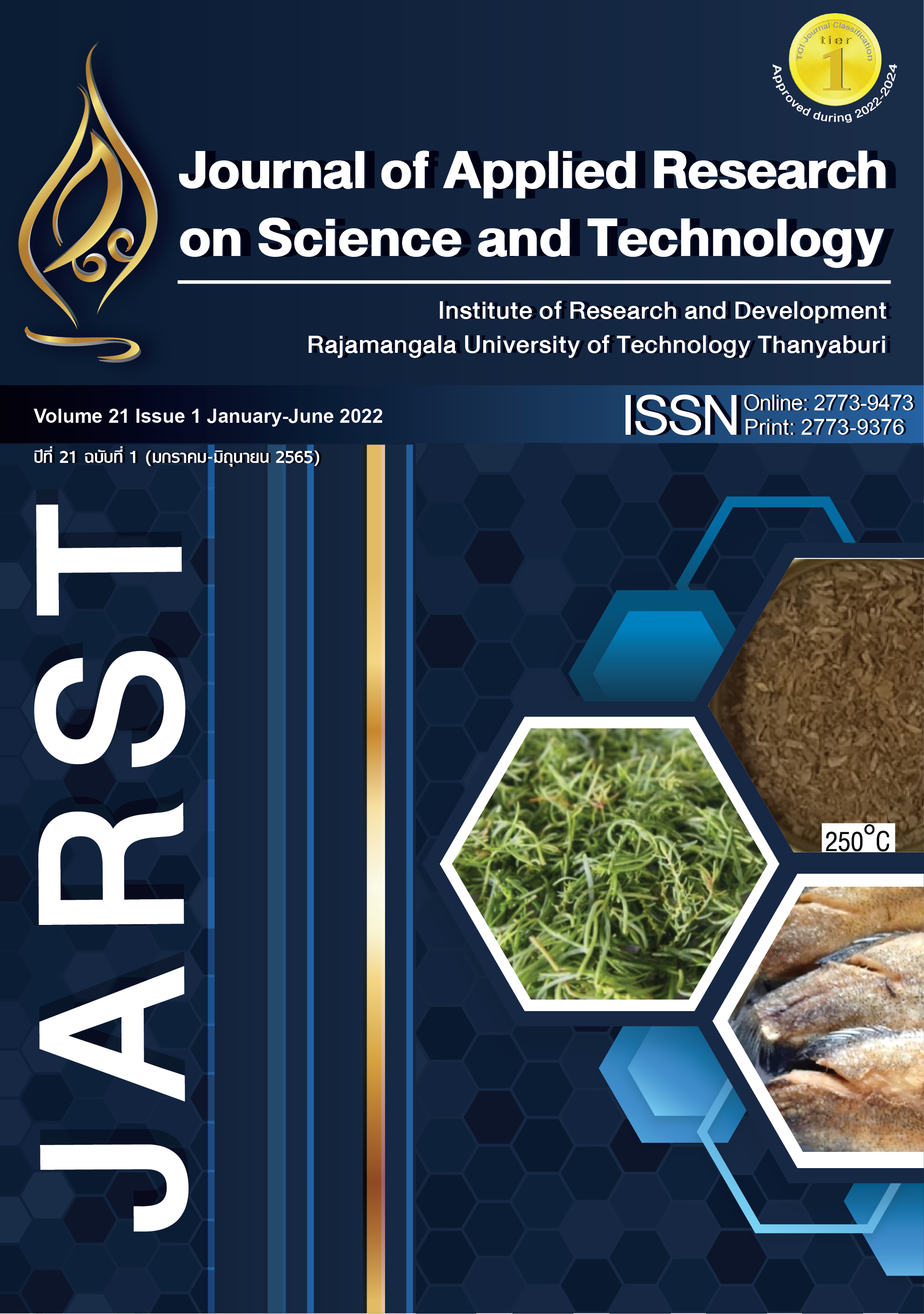Preparation of Mao (Antidesma thwaitesianum Muell.Arg) Extract Niosomes for Skin Care Product
Main Article Content
Abstract
The objective of this research was to utilize the residual black Mao pulp and seeds from the production process of Mao products. In the niosome form of Mao extract and applied in skin lotion product. The extracting the residual black Mao pulp with 50% concentration of ethanol solution, it was found that 100 ml of the extract contained all phenolic compound, total anthocyanin and antioxidant capacity compared to ascorbic acid at the highest of 3,725.27 mg gallic acid, 28.57 mg cyanidin-3-glucoside and 3,570.33 mg ascorbic acid, respectively. The Mao extract was developed into niosomes by Chloroform film method and the particle sizes were reduced by Ultrasonic probe and Microfluidizer. The ratio of Tween 60 and cholesterol at 30:70 was used. The particle size of Mao extract niosome was 252.19 nm and polydispersity index (PDI) was 0.26. Niosomes colloid of 2% Mao extract had antioxidant activity at 84.11 mg ascorbic acid/100ml, total phenolic acid at 78.10 mg gallic acid/100ml, total anthocyanin at 3.78 mg cyanidin-3-glucoside/100ml and oxygen radical absorbance capacity (ORAC) at 7,775.71 µmol TE/100ml. From the application of Mao extract niosomes in skin care product (10%), it was showed that the product had antioxidant activity at 9.12 mg ascorbic acid/100ml, total phenolic acid at 41.86 mg gallic acid/100ml, ORAC at 678.04 µmol TE/100ml, total anthocyanin at 0.27 mg cyanidin-3-glucoside/100ml and anti-tyrosinase efficient (IC50) less than 1,000 mg/ml.
Article Details

This work is licensed under a Creative Commons Attribution-NonCommercial-NoDerivatives 4.0 International License.
References
Mukherjee PK, Niladr Mi, Neelesh KN, Birendra KS. Bioactive compounds from natural resources against skin aging. J Phytomedicine. 2011;19(1):64-73.
Nadkarni AK. Indian Materia Medical (Revised and Enlarged). vol.II. 3rd ed. Popular Book Depot: Bombay; 1976.
Mamgain RK. Acne Vulgaris and its Treatment by Indigenous Drugs SK34 (Purim) and SK-235 (Clarina). the Antiseptic. 2000;97(3):76-8.
Kim S, Chung JH. Berberine prevents UV-induced MMP-1 and reduction of type I procollagen expression in human dermal fibroblasts. Phytomedicine J. 2008;15(9):749–53.
Puangpronpitag D, Areejitranusorn P, Boonsiri P, Suttajit M Yongvanit P. Antioxidant activities of polyphenolic compounds isolated from Antidesma thwaitesianum Müll. Arg. seeds and marcs. J Food Sci. 2008;73(9):C648-53.
Panich A. Antioxidants and the inhibition of skin aging. In: Angwanith V, editor. Free radicals and antioxidant. Health Innovation Publishing; 2012. Thai.
Promkhan S, Wongbasg C, kumpita A. [Utilization of black Mao pomace extract in hand cleansing gel product]. JARST. 2018;17(1):23-32. Thai.
Karakaya S, El SN, TAS AA. Antioxidant activity of some foods containing phenolic compounds. Internation¬al J Food Sciences and Nutrition. 2001;52(6):501–8.
Daduang J, Vichitphan S, Daduang S, Hongsprabhas P, Boonsiri P. High phenolics and antioxidant of some tropical vegetables related to antibacterial and anticancer activities. AFR J Pharm Pharmaco. 2011;5(5):608-15.
Giusti MM, Wrolstad RE. Charcterization and measurement of anthocyanins by UV-Visible spectrocscopy. In: Wrolstad RE, editor. Current Protocols in Food Analytical Chemistry. New York: John Wiley & Sons Inc.; 2001. p. F1.2.1-F1.2.13.
Manosroi A, Wongtrakul V, Manosroi J, Sakai H, Sugawara F, Yuasa M, et al. Characterization of vesicles prepares with various non-ionic surfactants mixed with cholesterol. J Colloids Surfaces. 2003;30:129-38.
Prior RL, Hoang H, Gu L, Wu X, Bacchiocca M, Haward L, et al. Assays for hydrophilic and lipophilic antioxidant capacity (oxygen radical absorbance capacity (ORACFL)) of plasma and other biological and food samples. J Agr Food Chem. 2003;51:3273-9.
Long ZP, Park HR, Park YK, Lee SK, Park JH, Park MK. Mushroom tyrosinase inhibition activity of some chromones. J Chem Pharm Bull. 2002;50(3):309-11.
Thai Industrial Standards Institute. Standards industry of skin products. TIS. 478-2555. 2555. Thai.
Loiphiman P, Phasakul T, Mongkoithai R. Comparison of antioxidant active and total phenolic compounds of fruit peels. Agr Sci J. 2011;42(2):385-8.
Robards, K, Prenzler PD, Tucker G, Swatsitang P, Glover W. Phenolic compounds and their role in oxidative process in fruit. J Food Chem. 1999:66(4):401-36.
Roungjacpetch A. Effect of Indian Gooseberry Browning and Spanish Plum Maturity on Total Phenolics, Flavonoids and Antioxidant Activities. [Master of Science Thesis]. Bangkok: kasetsart University; 2007. Thai.
Leelapornphisit P. Cosmetics for the skin. 2nd ed. Odeon store Publishing house; 2008. P.264 Thai.
Flober-Muller H, Champ S, Kandzia C, Jung K, Seifert M, Herrling T. Strategy for Efficient Prevention from photo-ageing. SOFW J. 2008:134(8):23-32.
Mishra AK, Mishra A, Chattopadhyay P. Herbal cosmeceuticals for photoprotection from Ultraviolet B radiation. Trop J Pharm Res. 2011:10(3):351-60.
Kusumawati I, Indrayanto G. Natural Antioxidants in Cosmetic. In: Atta-ur-Rahman, editor. Studies in Natural Products. Oxford United Kingdom: Elsevier press; 2013. p. 485-505.
Yoshida H, Lehr CM, Kok W, Junginger HE, Verhoef JC, Bouwistra JA. Niosomes for oral delivery of peptide drugs. J Controlled Release.1992;21:145-54.
Pongphisut S. Developments of anti-aging cream product with silk protein niosomes. [Master of Science Thesis]. Bangkok: kasetsart University; 2011. Thai.
Agarwal R, Katare OP, Vyas SP. Preparation and in vitro evaluation of liposomal/niosomal delivery systems for antipsoriatic drug dithranol. Int J Pharmaceut. 2001;228:43–52.
Porasupatthana S. Measurement technique of Oxidative Stress. In: Angwanith V, editor. Free radicals and antioxidant. Health Innovation Publishing; 2012. p.129-92. Thai.


